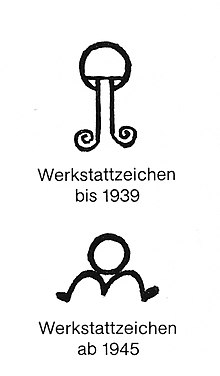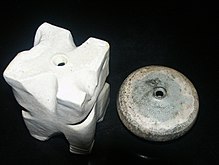Otto Meier (ceramist)
Otto Meier (born March 18, 1903 in Dortmund , † June 1, 1996 in Worpswede ) was a German ceramist .
Otto Meier, the silent master of the 20th century , is still considered a role model by many ceramists today. His work is represented in important public and private collections.
Life
From 1924 Otto Meier studied architecture and sculpture at the Kunstgewerbeschule in Dortmund. A visit to Bernhard Hoetger in Worpswede in 1925 brought him to ceramics. In Hoetger's workshop he began an apprenticeship under Willi Ohler , who left the Hoetgerschen Kunsthütten three months after the start of training.
Meier continued his autodidactic training and took over the ceramics workshop in Hoetgers Kunsthütten. In 1926 he made the seven lazy people designed by Hoetger for Bremen's Böttcherstraße . In 1927 he took over the pottery workshop in Böttcherstraße, where he worked until 1939, but occasionally still worked for Hoetger in Worpswede.
The Bremen entrepreneur and art patron Ludwig Roselius financed a three-semester stay at the Bunzlau Ceramic College (1929/1930), where he studied glazing technology with Eduard Berdel .
From 1939 to 1945 Otto Meier took part in the war as a soldier. Since he found the workshop in Böttcherstraße destroyed on his return, he built a new workshop in Worpswede in 1945, where he worked until the end of his life. In 1950 he married the tapestry weaver Gisela Harwart in Worpswede. From 1988 to 1995 he was a member of the German Ceramists' Association - Group 83 .
plant
His early, idiosyncratic works - often works based on designs by Bernhard Hoetger - are not yet glazed, but simply painted with engobe and reworked using a kind of sgraffito technique. Shapes and motifs were shaped on the one hand by Hoetger's preference for Latin American ceramics and on the other hand by Constructivist , a completely new phenomenon in ceramics of the time. After studying in Bunzlau, Meier radically simplified his vessel shapes. The main motif is the rotated unique vase with a narrow neck. He is now more interested in the constantly evolving surface technologies. The mostly matt glazes show an infinite variety of color nuances and structures. Otto Meier's early works were made of burnt earthenware and since 1958 made of stoneware , from 1978 he also worked in porcelain . In addition to the twisted vessels, powerful objects of sculptural quality were created.
Awards
- 1964: Lower Saxony State Prize for the craftsmanship , Hanover
- 1982: Westerwald Prize for the exposed ceramic vessel, Höhr-Grenzhausen
- 1986: Auguste Papendieck Prize , Bremen
- 1988: Member of the Académie Internationale de la Céramique in Geneva
- 1988: Honorary Prize German Ceramics, Höhr-Grenzhausen
literature
- Heinz-Wilhelm Haase: Otto Meier. In: Keramos. No. 83, 1979, pp. 77-80.
- Exhibition catalog Otto Meier, freely turned porcelain. Focke Museum, Bremen 1982.
- Exhibition catalog Otto Meier - Art in the Keramion. Issue 22, Frechen 1884.
- Exhibition catalog Otto Meier. Focke Museum, Bremen 1986.
- Exhibition catalog Honorary Prize German Ceramics 1988 Otto Meier. Ceramic Museum Westerwald, Höhr-Grenzhausen 1988.
Web links
- Literature by and about Otto Meier in the catalog of the German National Library
- Vita of Otto Meier with picture
| personal data | |
|---|---|
| SURNAME | Meier, Otto |
| BRIEF DESCRIPTION | German ceramic artist |
| DATE OF BIRTH | March 18, 1903 |
| PLACE OF BIRTH | Dortmund |
| DATE OF DEATH | June 1, 1996 |
| Place of death | Worpswede |

